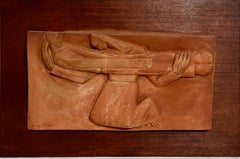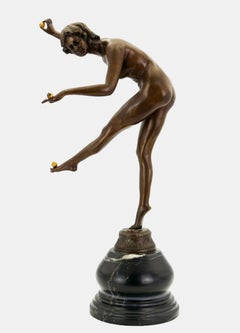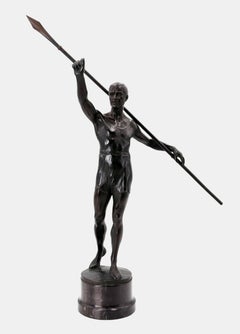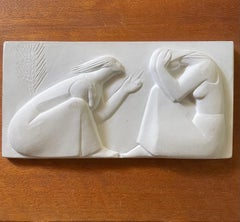George Aarons Nude Sculptures
to
1
Overall Width
to
Overall Height
to
1
1
1
1
1
1
1
3
86
31
28
23
1
Artist: George Aarons
Large George Aarons Terracotta Sculpture Relief Art Deco Plaque WPA Artist
By George Aarons
Located in Surfside, FL
Two Figures (Mother and son)
9" x 17" terracotta sculpture, signed lower left mounted to wood panel, 15 1/2" x 23 1/2"
George Aarons (born Gregory Podubisky, in St. Petersburg, Russ...
Category
20th Century Art Deco George Aarons Nude Sculptures
Materials
Wood, Terracotta
Related Items
Juggler / - Artistic naturalness -
Located in Berlin, DE
Claire Jeanne Robertine Colinet (1880 Brussels - 1950 Asnières-sur-Seine), Juggler, around 1920. Brownish patinated bronze with gilded balls on a round, multi-profiled stone base (10...
Category
1920s Art Deco George Aarons Nude Sculptures
Materials
Bronze
$3,428
H 18.51 in W 7.88 in D 9.85 in
Javelin thrower / - Roman present -
By Franz Iffland
Located in Berlin, DE
Franz Iffland (1862 Tempelhof - 1935 Berlin), Javelin thrower, after 1910. Olive-black patinated bronze with cast plinth mounted on a white-veined black marble base (7 cm high). Tota...
Category
1910s Art Deco George Aarons Nude Sculptures
Materials
Bronze
$2,364 Sale Price
20% Off
H 24.02 in W 10.24 in D 9.85 in
Torso of a Woman
Located in PARIS, FR
Torso of a Woman
by Marcel GIMOND (1894-1961)
Avery fine nuanced brown chamotte sandstone sculpture
raised on a dark grey marble base
signed on the arm with the monogram "MG" for Marcel Gimond
inscribed with the monogram "GS" for Georges Serré
stamped by the galerie Rouard
France
1927
total height 50 cm
width 20,5 cm
depth 20 cm
After a model by Marcel Gimond, this bust was made in 1927 by Georges Serré at the Manufacture de Sèvres, sold exclusively by the Rouard Gallery, and exhibited the same year at the Paris Fall Fair (Salon d'Automne).
Reproduced in "Sculpteurs nouveaux, Marcel Gimond", Paul Fierens, Nrf, 1930, cover.
Biographies :
Marcel Gimond (1894-1961) was a French sculptor. He studied in Lyon, then at the School of Fine Arts in Lyon where he graduated in 1917. Finally he arrived in Paris the same year and settled in Marly-Le-Roi. Student of Aristide Maillol, he also met Raoul Dufy and Auguste Renoir. Gimond worked with Maillol until 1920, and left him to settle in Paris and regain his independence. He then moved into Renoir's former studio, made available by Jean Renoir. He exhibited at the Salon des Indépendants and the Salon d'Automne in 1922. In 1940, Gimond left Paris to settle in the South zone, in Lyon, then in Aix en Provence; He spent his summers at Saint-Félicien, at the house of poet Charles Forot.
At the Liberation, in 1944, he returned to Paris and his workshop rue Ordener, he left only a few months before his death. From 1946 to 1960, he directed a workshop at the Ecole des Beaux-Arts in Paris. Marcel Gimond was known for his busts of political and artistic personalities. He also owed two bas-reliefs located in the lobby of the newspaper "L'Humanité", in tribute to Marcel Cachin and Gabriel Péri.
Georges Serré (1889-1956) was a French ceramist. He worked at the Sèvres factory until 1914, when he was mobilized to go to war. He then went to Indochina where he taught ceramics at the art school of Bien-hoa for five years. On his return to France, he moved to Sèvres, rue Brongniart, but encountered difficulties in producing his works, until the intervention of the ceramist Emile Decoeur who obtained him help to build an oven for firing his ceramics. It was Georges Rouard and his gallery located on avenue de l'Opéra in Paris, who had noticed him at the International Exhibition of Modern Decorative and Industrial Arts of 1925, which presented him during his "exhibitions of contemporary French artisans".
Georges Serré's taste for these sandstones came to him, among other things, from Khmer sculptures...
Category
1920s French School George Aarons Nude Sculptures
Materials
Terracotta
The Rudder, Terracotta, 1930s
By Ugo Cipriani
Located in Saint Amans des cots, FR
French Art Deco terracotta sculpture by Ugo Cipriani (1887-1960), France, 1930s. A man operating a rudder. Measurements : Width : 31"(79cm), Height : 16.7"(42.5cm), Depth : 8.7"(22cm...
Category
1930s Art Deco George Aarons Nude Sculptures
Materials
Terracotta
"La Comete" Iconic French Art Deco Silvered Bronze 1920s Female Nude
By Maurice Guiraud-Rivière
Located in New York, NY
"La Comete" Iconic French Art Deco Silvered Bronze 1920s Female Nude
Maurice Guirard-Riviere (1881 - 1947)
La Comete
Silvered bronze
23 inches wide x 19 3/4 inches high x 5 1/2 inc...
Category
1920s Art Deco George Aarons Nude Sculptures
Materials
Bronze
Maurice Guiraud-Rivière"La Comete" Iconic French Art Deco Silvered Bronze 1920s Female Nude, c. 1925
$40,000
H 20 in W 23 in D 5 in
"Mercury" NYC 1931 Bronze 5th Ave Traffic Light Sculpture American Art Deco WPA
Located in New York, NY
"Mercury" NYC 1931 Bronze 5th Ave Traffic Light Sculpture American Art Deco WPA
In the late 1920s, Joseph Freedlander was asked by the City of New York ...
Category
1930s Art Deco George Aarons Nude Sculptures
Materials
Bronze
$40,000
H 18 in W 9 in D 6 in
Sculpture Terracotta Female Nude From Marcel Bouraine (1886-1948)
By Marcel-André Bouraine
Located in Saint-Ouen, FR
Sculpture Terracotta From Marcel Bouraine (1886-1948)"
Original terra cotta sculpture of Marcel Bouraine
Naïade of the 1930's Signed Bouraine
On the ...
Category
1930s Academic George Aarons Nude Sculptures
Materials
Terracotta
$5,501
H 23.63 in W 15.75 in D 15.75 in
Dance of Carthage
By Claire J. R. Colinet
Located in PARIS, FR
Dance of Carthage
by Claire-Jeanne-Roberte COLINET (1880-1950)
A bronze sculpture with gilded patina
Signed on the base " Cl.J.R. Colinet "
Old Per...
Category
1920s Art Deco George Aarons Nude Sculptures
Materials
Bronze
Unveiling - Sculpture by Maryam Pezeshki - 2021
Located in Roma, IT
Unveiling is a contemporary artwork realized by Maryam Pezeshki in 2021
Terracotta sculpture.
Original title: Svelamento
Maryam Pezeshki was born in Tehran on August 18, 1977. SHe began to paint at the age of three. Her first painting was a Pinocchio. Participate in national and international painting competitions and festivals among Asian and Iranian children, winning first prize each time. At the age of ten she participated in a television program entitled "Little Great Artists". At the age of fourteen she won the prize for the best drawing and sculpture among Iranian teenagers, and she enrolled in the artistic high school, continuing to do her first personal exhibitions of sculpture, painting and drawing. From the age of seventeen to nineteen she won the national prize for best sculpture at the youth festival for three consecutive years. At seventeen he enrolled at the University of Art in the graphics sector and at twenty-one he graduated with full marks. In the same year she began studying for the master of graphics and managed to be among the seven students admitted. At the age of twenty-five she finished his studies and won a competition for teaching drawing and sculpture at the University of Art. In the meantime, visit the European and Indian museums...
Category
2010s Contemporary George Aarons Nude Sculptures
Materials
Terracotta
$3,587
H 14.57 in W 7.88 in D 7.88 in
Kneeling Female Nude, Bronze By Mario Korbel
Located in Norwood, NJ
Joseph Mario Korbel (Czech/American, 1882-1954). Period fine example bronze, dark brown patina, modeled as a nude female kneeling and tying her sandal, raised on a stepped black marb...
Category
Early 20th Century Art Deco George Aarons Nude Sculptures
Materials
Marble, Bronze
Artista fiorentino del XVII secolo da Verrocchio putto fontana in terracotta
Located in Florence, IT
Questa statua in terracotta in eccellente stato conservativo considerata l'età e la fragilità del materiale, raffigura un putto nell'atto di soffiare, colto in una posa di intenso p...
Category
17th Century Renaissance George Aarons Nude Sculptures
Materials
Terracotta
$17,938
H 25.99 in W 8.27 in D 15.75 in
Terracotta figurativa italiana a tema mitologico dei primi del Novecento
Located in Florence, IT
Piccola terracotta a soggetto mitologico firmata sul retro sulla base "Zambini", che per la grafia (in particolare la Z che ricorda una F) permette di identificar...
Category
Early 20th Century Renaissance George Aarons Nude Sculptures
Materials
Terracotta
Previously Available Items
George Aarons Plaster Sculpture Relief Art Deco Plaque WPA Artist Ruth & Naomi
By George Aarons
Located in Surfside, FL
Size includes wood mounting.
George Aarons (born Gregory Podubisky, in St. Petersburg, Russia, 1896 - died in Gloucester, Massachusetts 1980) was a distinguished sculptor who lived and taught in Gloucester, Massachusetts, for many years until his death in 1980. He had, many students in the area and he designed Gloucester's 350th Anniversary Commemorative Medal.
Aarons moved from Russia to the United States when he was ten. His father was a merchant. He began taking drawing classes during evenings at Dearborn Public School in Boston as a teenager and went on to study at the Boston Museum of Fine Arts in 1916. Aarons later moved to New York City to study with Jo Davidson, and other Paris-trained masters at the Beaux-Arts Institute. He eventually returned to the Boston area and established studios in Brookline and Gloucester, Massachusetts. During his lifetime, he was recognized internationally and won several prestigious awards. Aarons had studios in Brookline, Massachusetts and Gloucester, Massachusetts where he produced large bronze and marble figures and wood carvings. He produced several projects for the Works Progress Administration including a group of three figures for the Public Garden (Boston), a longshoreman, fisherman and foundry worker, as well as a large relief (1938) for the South Boston Housing Project and façade of the Baltimore Hebrew Congregational Building (1956).
His works are at the Museum of Art in Ein Harod, Israel; Fitchburg Art Museum in Massachusetts, Musée de St. Denis in France; Hilles Library at Radcliffe College in Cambridge, Massachusetts; and Hillel House at Boston University in Massachusetts.
He did reliefs for Siefer Hall at Brandeis University in Waltham, Massachusetts (1950); Edward Filene (the founder of Filene's Department Store and a philanthropist) on the Boston Common; Fireman's Memorial in Beverly, Massachusetts; a memorial to Mitchell Frieman in Boston; the U.S. Post Office in Ripley, Mississippi; and at the Cincinnati Telephone Building; the Combined Jewish Philanthropies building in Boston (1965); and a commemorative medal for the 350th Anniversary of the City of Gloucester, Massachusetts (1972).
Characteristic of his era, George Aarons was among the foreign-born American sculptors of the early 20th century who started their careers as academicians and evolved into modernists and increasingly abstract artists.
Over thirty pieces spanning the length of this sculptor's career were featured in this exhibition, including work in various medium bronze, wood and original plasters. Like his contemporaries, Aarons experimented with direct carving in wood, and he was one of the few academically trained sculptors who consistently cut his own works in marble. His early work was classically inspired figurative work, along with sensitive portraits. Some of his most powerful sculpture comes from his middle period, when he worked through his emotional pain following the global realization of the Jewish Holocaust. He depicted humanity deep anxiety over this tragedy with figures that are at once symbolically charged and movingly beautiful. Aarons late work consists of radically simplified forms that continue to reference the human form and often are carved directly in wood and stone.
Aarons summered and taught classes on Cape Ann for many years before moving to Gloucester full-time with his wife about 1950. While Aarons is best known locally for his domestic-scale works, he also executed numerous monumental, public commissions that can be found throughout the United States in cities such as Washington, D.C.; Baltimore, Maryland; and Cincinnati, Ohio; as well as in France and Israel.
As noted in a Gloucester Daily Times Article, Aarons wanted his sculptures to honor the struggles and nobility of people and rail against the evil done against them. And that was why, even as his work grew more and more abstract, stylized and simplified, he never left behind the form of the human figure that had been his focus from his earliest works.
Aarons told the Gloucester Daily Times in September 1954 that he found it hard to remember at just what age he started studying art, but he recalled that the nude model had to partially dress when he was in class because he was so young. He initially studied painting and drawing at the museum school, but he once said he became fascinated by sculpture when he met an established sculptor at the Copley Society in Boston who invited Aarons to his studio and offered him some clay to "play around" with.
After he graduated, he apprenticed under sculptors Richard Brooks, Robert Baker and Solon Borglum. He worked as a carpenter, shipbuilder, dishwasher and chimney sweep. He fashioned architectural decorations, including figures for fountains and now and then a few commissioned portraits. He returned to Boston by the early 1920s and began to exhibit his own works and get commissions for portraits, fountains and reliefs.
His sculptures from this time are dreamy and romantic in the realistic, academic style of the time. A painted portrait of the young Aarons that is included in the North Shore Arts Association exhibit shows a determined fellow with dark brown hair, a suit and bow tie. However, in 1922, this determined young artist was living with his parents on Calder Street in Dorchester.
In the 1930s, Aarons adopted the streamlined, monumental style of the socialist works of the time. Aarons made money, as he would all his life, from commissions, selling his personal work and teaching sculpture, but the Depression of the 1930s was tough for everyone.
So Aarons found work though the federal Works Progress Administration, one of Franklin Roosevelt's New Deal programs. He received his first major commission when he was asked to create a public sculpture for the South Boston Harbor Village public housing project around 1937. He was elevated to the position of supervisor for the project and received a corresponding $5 pay increase to make his weekly salary $32. The raise convinced him he was fit to marry and he proposed to Gertrude Band, an attractive brunette dancer whom he had been dating for more than a year. They were married before the Harbor Village project was dedicated on Labor Day 1938.
Aarons' design featured a brawny, larger-than-lifesize fisherman, longshoreman and a laborer flanked by a boy and girl at either end to portray the children who would live in the apartments. Aarons elected to do the piece in cast stone to employ carpenters and laborers as well as craftsman for a total of 10 men.
In his sculpture, Aarons focused more and more on the theme of oppressed people as he worried about the spread of fascism and Nazism during the 1930s, World War II and after. He had done pieces during the mid-1930s about the oppression of African-Americans, including "Negro Head," which is in the North Shore Art Association retrospective. After the war, he also delved into Jewish themes and became increasingly known as an important Jewish artist, leading to commissions from Jewish organizations across the country and abroad.
"He gets into raw emotion. Some people describe him as an expressionist because of the emotion (in his work)," Reynolds says.
But Aarons, also sculpted sensual sexual nudes...
Category
20th Century Art Deco George Aarons Nude Sculptures
Materials
Plaster, Wood
George Aarons nude sculptures for sale on 1stDibs.
Find a wide variety of authentic George Aarons nude sculptures available for sale on 1stDibs. You can also browse by medium to find art by George Aarons in ceramic, terracotta, wood and more. Much of the original work by this artist or collective was created during the 20th century and is mostly associated with the Art Deco style. Not every interior allows for large George Aarons nude sculptures, so small editions measuring 24 inches across are available. George Aarons nude sculptures prices can differ depending upon medium, time period and other attributes. On 1stDibs, the price for these items starts at $2,200 and tops out at $2,200, while the average work can sell for $2,200.



